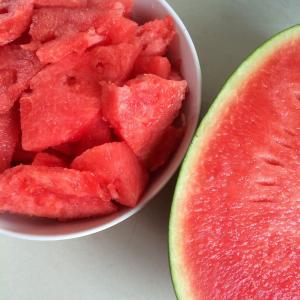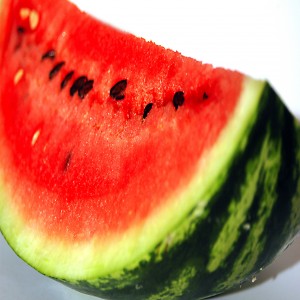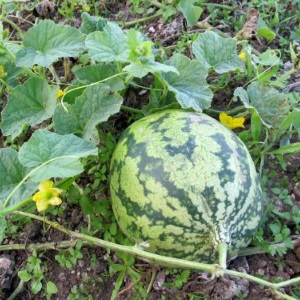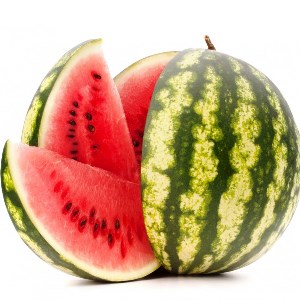Why watermelon is not sweet: causes of the problem and how to prevent it
Many gardeners in our country have tried to grow watermelons on their plots. It turned out that even in Siberia, you can get huge striped fruits weighing 15-17 kg. But the harvest is not always pleasing with its taste. In this article, we will tell you why watermelon is not sweet and how to avoid it.
The content of the article
Reasons why watermelon is unsweetened
Gardeners often have to be disappointed: a lot of striped berries have grown, everything looks beautiful, but the pulp has no sweetness. There are also bad watermelons in your garden this year, and you don't understand why this is happening? Let's consider the main reasons in more detail.
Unfavorable weather conditions

Melons and gourds love high air temperatures - above + 30 ° С. If during the growing process the temperature stays below + 15 ° C, the fruits will stop growing and the crop will be unsweetened.
The process of photosynthesis slows down in cloudy weather, so sugar in watermelons does not accumulate. Even if the summer was sunny, but the plants were planted in a shaded place, they will still taste bad.
The taste of watermelon and constant winds are bad. Their effect slows down plant growth and can cause mechanical damage.
Watering errors
Reduces the sugar content of the pulp and frequent watering. Young plants are irrigated no more than once a week, and from the middle of summer - only once every two weeks. At the same time, only warm water is used for irrigation (from +22 to + 30 ° C).
Lack of fertilizer
The lack of mineral fertilizers in the soil also reduces the sugar level in watermelons. It is optimal to feed the plants with complex fertilizers containing zinc, iron, boron and manganese. They are brought into the hole when landing or using drip irrigation.
Organic fertilizers are applied in advance - in the fall. Their number should not exceed 8 kg per meter. If the soil on your site is fertile, it is not recommended to add organic matter.
Important! Excess nitrogen in the soil impairs the taste of the fruit, making them unsweetened.
Features of the variety
Late varieties of watermelon are usually sweeter than earlier varieties. But when choosing seeds, it is important to understand that large-fruited varieties can grow up sweet only in the southern regions. If the summer in your area is rainy and not too hot, it is better to choose varieties with small fruits.
Even in the most unfavorable summer, such varieties and hybrids as: Golden Tiger F1, Lady F1, Golden, Gift of the Sun, Sagi F1, Prince Danish F1, Dumara F1, grow sugary.
Why there may be bad watermelons in a certain year
Sometimes the watermelon harvest can turn out to be unsuccessful en masse in a particular region. There are several reasons for this:
- The melon culture does not tolerate prolonged cold snap, prolonged cloudy or rainy weather. The berry does not like damp places, cold earth and stagnant cold air.
- The worst thing for a watermelon, as for any melon crop, is a lack of sunlight. In such conditions, female flowers rot, barely tied or not having time to do this at all.
- During periods of high air humidity and low temperatures, pests and diseases actively reproduce, which also harms the watermelon crop.
How to properly grow sweet watermelons
In our country, many gardeners try to grow watermelons on their plot, but not all of them grow sugary.Consider how to do it right to enjoy the sweet pulp.
Optimal drop-off location

It is important to choose a suitable land for planting seeds. This plant needs maximum sun and warmth.
It is best to grow fruits on the southern slopes, without the slightest shade - there should be no trees or shrubs nearby.
Proper watering
Watermelon tolerates drought well and does not require frequent watering. But moisture is needed during the period of rapid growth of green mass. During this period, plants are watered once a week.
After the striped berries reach the size inherent in the variety, the bushes are watered every 14 days.
For the entire growing period, melons and gourds are watered 7-8 times. Two weeks before harvesting, watering is completely stopped.
Important! If it rains during this period, the plants are covered.
The sweetest varieties
Twinkle - one of the varieties most beloved by gardeners, unpretentious and medium-sized. In appearance, the fruits are unusual: a dark, monochromatic crust without stripes. Early ripening and incredibly sweet variety with delicate flesh.
Crimson Sweet has an average ripening period, rich sweet taste, red flesh. Suitable for southern areas.
Sugar baby - unpretentious and tasty variety, it is successfully grown in most regions of our country. Fruit weight - 2-4 kg. The crust is dark, practically without pattern.
Winner 395 - the variety is very sweet. Fruits are small, 4-6 kg, slightly elongated in shape.
Zenith also suitable for mid-latitudes. Sugar fruits, weighing 2.5-6 kg.
Secrets of summer residents

When growing melons and gourds in cool conditions, the problem of the appearance of rot often arises. Dampness can rot not only fruits, but even shoots. To prevent this, a plate is placed under each fruit, three handfuls of sand are poured at the root collar.
It is important not to overdo it with watering - they are needed only in extreme heat. The day after it, the soil is loosened and mulched so that a crust does not form on the surface.
In a cool, short summer, a large number of berries will not have time to ripen on one bush. Therefore, no more than five watermelons are left on each plant.
reference... If it is always windy on your site, sowing curtains - strips of winter wheat or rye - will help to protect the plants. Experienced gardeners sow them in the fall, as they should be fully grown by the day the watermelons are planted in the open field.
How to choose the right sweet watermelon when buying
Fragrant large berries have been on sale since the end of June. But even early varieties cannot ripen at this time without the addition of chemicals, and it still takes time for transportation. Therefore, it is recommended to buy watermelons in August and September, when their natural ripeness begins.
Here are some of the main signs of a delicious sweet fruit:
- the stripes forming a pattern on the peel should be clear;
- the peel is glossy, not matte;
- the crust is hard, it will not work without effort;
- a yellow spot on the side - in this place the watermelon was lying on the ground - should be a rich yellow color.
Medium-sized fruits are the best choice as large watermelons may have been grown using nitrates.
Conclusion
When growing watermelons, it is important to take into account the peculiarities of the local climate and try to protect the planting from unfavorable conditions: cold, excessive rains, shading and other negative factors.
By choosing the right variety and creating comfortable conditions for the plants to grow, you will certainly get a fragrant and sweet harvest.